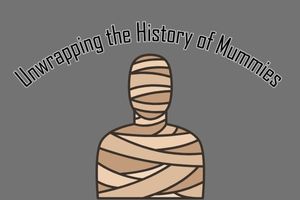Zombies, skeletons, werewolves, vampires, and witches – all monsters often associated with the terror of Halloween. However, chances are when-ever you roam the streets on October 31st there is one costume that kids may not dress up as much, one monster that isn’t as popular, and usually isn’t categorized with the other big and terrifying monsters: the Mummy.
The History of Mummification
Mummification is the preservation of deceased bodies. The process varies depending on the culture, and many people throughout history found their own unique ways to practice mummification. Their main goal was to preserve as much of the human body as possible.
The History of the Mummy and Halloween
When people think about Mummies, many envision a gigantic body wrapped up in multiple layers of gauze, with dark golden eyes with an evil gaze. During Halloween, tales of the Mummy spark interest to thrill seekers. However, the legend of the Mummy originally came from ancient Egypt. Stories of mummies first appeared as early as 1699, when Irish author Bram Stoker created the first headline story about the Mummy as a supernatural antagonist. Stroker’s idea for this novel was that the protagonist would aim to revive Queen Tera, an Egyptian mummy, through an archaeology plot.
The next big break for this monster was when a German-American film producer, Carl Laemmle Jr, was inspired by the success of the film Dracula. Soon after this, The Mummy, a film based on the “Pharaohs Curse”, – a curse alleged to be cast upon anyone who disturbs the Mummy of Egypt, was released. After this appearance, the Mummy became a classic Halloween staple.
The Current Day Mummy
Stories about mummies continue to pop up in current times. For example, as recent as early 2023, archaeologists found the mummified remains of a man named Hekashapes who lived in circa 2300 BC. What historians found strikingly interesting was that Hekashape had been preserved in gold leaves that were laid carefully on his skin.
Mummification has similarly reemerged among 21st century celebrities, and oddly enough, pet owners. This is because a new technique called “pet mummification” has piqued the interest of many. Pet mummification allows owners to feel close to their companion long after their time has come. The process is relatively simple and easy, and only takes 90 days to complete. Traditional Egyption mummification allows the animal’s appearance to seem almost life-like. This strange yet popularized technique, allows pet owners to keep their beloved companion and hold on to their memories.
From its origin thousands of years ago, to its reappearance in present time, the Mummy continues to evolve throughout the years, and is still a vital part of various cultures,now representing the spooky holiday that is Halloween.




















